While laptops based on Nvidia RTX graphics chips have been available in stores for a while, the mobile versions of the lower-tier and more affordable GTX 1650 and 1660Ti Turing chips will only make their way inside notebooks from the second part of April 2019.
We’re already working on several different reviews of GTX 1650 and 1660 Ti laptops, and we’ll further update the article with our findings once those are finished.
In the meantime, in this article, we’ll tell you what to expect from these Nvidia chips and what are the main similarities and differences between them, the higher-tier (and at the same time most affordable GPU with support for RayTracing) RTX 2060 GPU and the older GTX 960M and GTX 1060 GPUs, which power the vast majority of the gaming laptops you might look to replace this year.
We’ll also compile a detailed list of all the available GTX 1650/1660Ti laptops down below, in the second part of the article.
For starters, here’s a quick specs sheet of the GTX 1650/1660Ti chips, next to the next best thing, the RTX 2060, and the older chips that they replace in budget gaming laptops.
| GTX 1660 Ti | GTX 1650 | RTX 2060 | GTX 1060 | GTX 960M | |
| Architecture | Turing | Turing | Turing | Pascal | Maxwell |
| Shaders | 1536 | 1024 | 1920 | 1280 | 640 |
| Tensor Cores | – | – | 288 | – | – |
| RayTracing Cores | – | – | 36 | – | – |
| Base Clock | 1140 – 1590 MHz | 1020 – 1560 MHz | 960 – 1200 MHz | 1404 – 1670 MHz | 1096 – 1202 MHz |
| Memory | 6 GB GDDR6 | 4 GB GDDR5 | 6 GB GDDR6 | 6 GB GDDR5 | 4 GB GDDR5 |
| TDP | 60-80 W | 35-50 W | 80-90 W | 60-80 W | 60 W |
I’ve also added a short list of benchmark results down below, but only take them as a general reference between platforms, as each implementation performs differently, based on the thermal solution’s ability to keep the hardware at bay.
This table is also a work in progress, and we’ll update our findings as we review more of these Turing GTX laptops.
In very few words though, GTX 1660 Ti laptops should get within 10% of the existing RTX 2060 in most standard games, but, of course, lack any sort of RayTracing capabilities. Compared to the existing 1060 laptops of the last years, GTX 1660 Ti units should provide 30-50% better gaming performance, varying between implementations.
GTX 1650 laptops, on the other hand, fall somewhere between existing GTX 1050 Ti and GTX 1060 3GB computers.
| GTX 1660 Ti 6 GB | GTX 1650 4GB | RTX 2060 6GB | GTX 1060 6GB | GTX 960M 4GB | |
| 3D Mark 11 | – | – | ~20400 points | ~14600 points | ~5300 points |
| 3D Mark – Fire Strike Graphics | ~14900 points | ~9200 points | ~15500 points | ~11500 points | ~4300 points |
| 3D Mark – TimeSpy Graphics | ~5600 points | ~3500 points | ~5800 points | ~3600 points | ~1150 points |
| Rise of Tomb Raider – FHD Very High | – | ~53 fps | ~82 fps | ~60 fps | ~26 fps |
| Battlefield V – FHD Ultra | ~ 80 fps | ~ 55 fps | ~95 fps | ~70 fps | ~26 fps |
| Bioshock Infinite – FHD Ultra | – | – | ~130 fps | ~102 fps | ~44 fps |
| Witcher 3 – FHD Ultra | – | ~50 fps | ~65 fps | ~38 fps | ~15 fps |
GTX 1650 laptops start at as low as $799, while GTX 1660 Ti models start at $999, but you’ll find various models beneath these MSRP prices down the road, once discounts start to kick in. We’ve included the important traits and shortcomings of each option, but you should definitely dig further into the devices that catch your attention, by reading the reviews and guides linked in each case. On top of that, if you’re interested in updated configurations and prices, you’ll find those by following the appropriate links.
With these out of the way, here’s the list of GTX 1650 and 1660 Ti laptops, both ultraportables and the full-size budget models, which sacrifice on weight and thinness for better performance and a much lower price tag.
Keep in mind we’re constantly updating this list, adding new info and products as they are launched, so just in case you found inaccuracies or something that should be in here and is not, please tell us about it in the comments section at the end.
| Model | Screen | Hardware | Graphics | TB3 | Weight |
| Acer Nitro 5 AN515-54 | 15.6 or 17.3-inch IPS FHD matte 60 Hz/144 Hz with Optimus | Coffee Lake Core H / max 32 GB RAM | GTX 1650 | No | 4.4 lbs / 2.1 kg |
| updated 2019 model; compact plastic build, standard form-factor; red backlit keyboard; 2x RAM, 2x M.2 SSD storage with RAID support; 58 Wh battery, 135 W charger | |||||
| Starting price: $799 |
|||||
| Acer Nitro 7 AN715-51 | 15.6-inch IPS FHD matte 60 Hz/144 Hz with Optimus | Coffee Lake Core H / max 32 GB RAM | GTX 1650, 1660 Ti | No | 4.9 lbs / 2.2 kg |
| new 2019 model; compact all-metal build, sturdier than the Nitro 5; red backlit keyboard; 2x RAM, 2x M.2 SSD storage with RAID support; 58 Wh battery, 135 W charger | |||||
| Starting price: $999 |
|||||
| Acer Predator Helios 300 PH315-52 | 15.6 or 17.3-inch IPS FHD matte 144 Hz with Optimus | Coffee Lake Core H / max 32 GB RAM | 1660 Ti | No | 5.5 lbs / 2.5 kg |
| reviewed here, new 2019 model; compact metallic build; 4-zone RGB backlit keyboard; 2x RAM, 2x M.2 SSD storage with RAID support; also available with RTX 2060 and 2070 Max-Q graphics | |||||
| Starting price: $1199 |
|||||
| Acer Predator Helios 300 PH317-53 | 15.6 or 17.3-inch IPS FHD matte 144 Hz with Optimus | Coffee Lake Core H / max 32 GB RAM | 1660 Ti | No | 6.5 lbs / 2.95 kg |
| reviewed here, updated 2019 model; 17-inch variant of the 15-inch model mentioned above, with a brighter screen, better speakers, improved performance and thermals | |||||
| Starting price: $1299 |
|||||
| Asus TUF FX505 DT/DU | 15.6-inch FHD matte 60/120 Hz with Optimus | AMD Ryzen APUs / max 32 GB RAM | GTX 1650, 1660 Ti | No | 4.9 lbs / 2.2 kg |
| reviewed here, hardware refresh of the 2018 model; compact plastic and metal build; white or optional RGB backlit keyboard, with 1.8 mm strokes; 2x RAM, 2x M.2 SSD storage with RAID support; 48 Wh battery | |||||
| Starting price: not yet available |
|||||
| Asus TUF FX705 DT/DU | 17.6-inch FHD matte 60 Hz with Optimus | AMD Ryzen APUs / max 32 GB RAM | GTX 1650, 1660 Ti | No | 6 lbs / 2.7 kg |
| reviewed here, hardware refresh of the 2018 model; compact plastic and metal build; red or optional RGB backlit keyboard, with 1.8 mm strokes; 2x RAM, 2x M.2 SSD storage with RAID support; 64 Wh battery | |||||
| Starting price: $999 |
|||||
| Asus ROG Strix Scar/Hero III G531GU | 15.6-inch IPS FHD matte 144/240 Hz with Optimus | Coffee Lake Core H / max 32 GB RAM | RTX 1660 Ti | No | 5.7 lbs / 2.6 kg |
| 2019 model, update of the Scar II variant reviewed here in another configuration; compact, but not as thin or light and other options; 4-zone backlit keyboard; matte 144 or 240 Hz FHD screen; up to Core i9-9880H processor, also available with RTX 2060 and 2070 GPU; 2x RAM slots, 1x M.2 NVMe storage + 2.5″ bay; 2x 4W speakers; 66 Wh battery, 180W adapter | |||||
| Starting price: – |
|||||
| Asus ROG Strix Scar/Hero III G731GU | 17.3-inch IPS FHD matte 144 Hz with Optimus | Coffee Lake Core H / max 32 GB RAM | RTX 1660 Ti | No | 6.3 lbs / 2.85 kg |
| 2019 model; 17-inch variant of the GL504 Scar III series, with similar traits and features; compact and fairly light for a 17-incher | |||||
| Starting price: – |
|||||
| Asus ROG Zephyrus G GA502GU | 15.6-inch IPS FHD matte 60/120 Hz with Optimus | AMD Ryzen 7 APU / max 32 GB RAM | GTX 1660 Ti MQ | No | 4.2 lbs / 2.1 kg |
| review here – new 2019 model; portable form-factor, thin, light and compact metallic build; 4 zone RGB lighting; matte 120 Hz FHD screen; AMD Ryzen 7 3750H APU and GTX 1660 Ti (60W) graphics, up to 32 GB of RAM (2x DIMM)s, 2x M.2 NVMe storage; 76 Wh battery, 230 W adapter, also charges via USB-C | |||||
| Starting price: $1200 |
|||||
| Asus ROG Zephyrus M GU502 | 15.6-inch IPS FHD matte 144/240 Hz with Optimus | Coffee Lake Core H / max 32 GB RAM | GTX 1660 Ti | No | 4.2 lbs / 1.9 kg |
| review here – new 2019 model; ultraportable form-factor, thin, light and compact metallic build; more compact than the Zephyrus G; 4 zone RGB lighting; matte 144 or 240 Hz FHD screens; also available with RTX 2060; up to 32 GB of RAM (2x DIMM)s, 2x M.2 NVMe storage; 76 Wh battery, 230 W adapter, also charges via USB-C | |||||
| Starting price: not yet available |
|||||
| Lenovo Legion Y540 15 | 15.6-inch IPS FHD 60/144 Hz matte with Optimus | Coffee Lake Core H / max 32 GB RAM | GTX 1650, 1660 Ti | No | 5.15 lbs/ 2.35 kg |
| update of the 2018 Legion Y530 model reviewed here, with some slight refinements; simple design, plastic build; white backlit keyboard; 60/144 Hz screens without GSync; 2x RAM slots, M.2 and 2.5″ storage; RTX 2070 Max-Q variant also available; stereo speakers; 52.5 Wh battery | |||||
| Starting price: not yet available | |||||
| MSI GL63 | 15.6-inch matte FHD TN 120 HZ | Coffee Lake Core H / max 32 GB RAM | GTX 1660 Ti | No | 4.9 lbs / 2.2 kg |
| reviewed here, update of the 2018 model; full-size laptop, mostly made out of plastic; SteelSeries keyboard with red lighting; 120 HZ TN matte screen; 2x RAM slots and M.2 + 2.5″ storage; capable 2x 3W speakers; 51 Wh battery, 180W adapter; also available with RTX 2060 GPU | |||||
| Starting price: from $999 – configurations and updated prices | |||||
| MSI GL73 | 17.3-inch matte FHD IPS 144 HZ | Coffee Lake Core H / max 32 GB RAM | GTX 1660 Ti | No | 5.95 lbs / 2.75 kg |
| 17-inch variant of the GL63, with similar traits and specs | |||||
| Starting price: from $999 – configurations and updated prices | |||||
That’s about it for now, but as already mentioned, we’re constantly updating this list of Turing GTX laptops, so stay tuned for changes.
On top of that, if your budget allows, our lists of entry-level RTX 2060, mid-range RTX 2070 and top-tier RTX 2080 laptops might also come in handful.

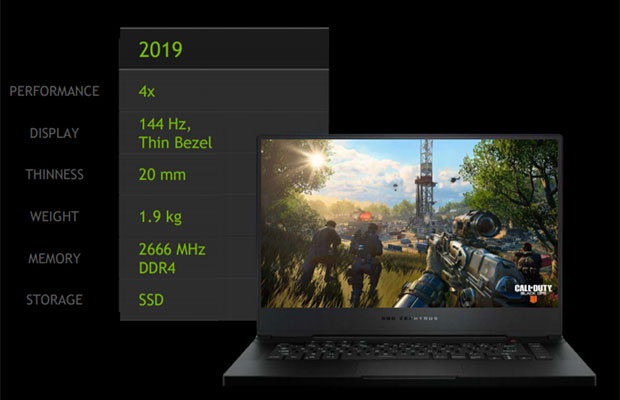
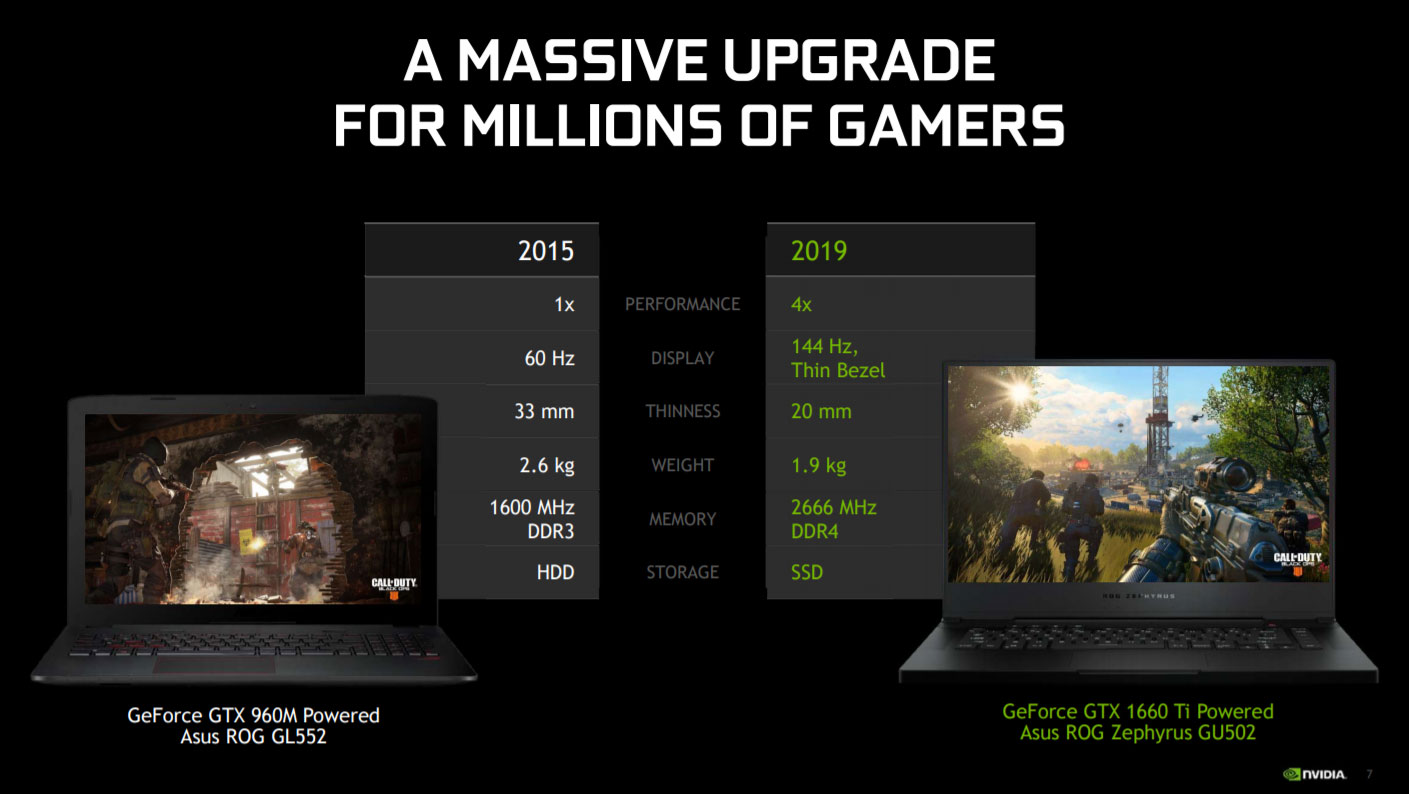
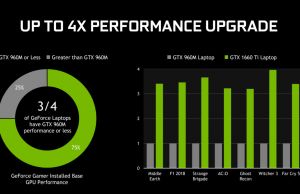
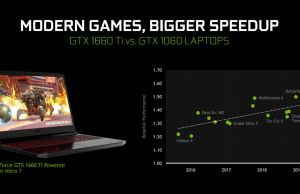
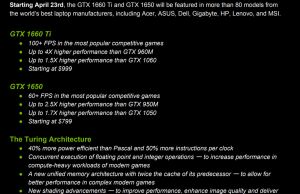


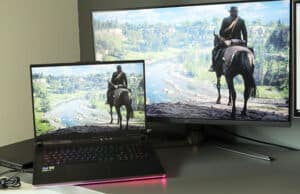
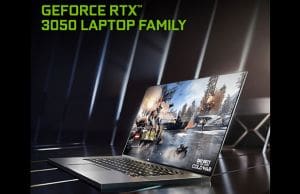
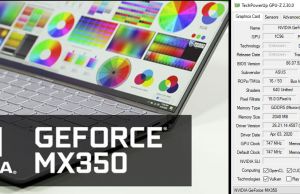
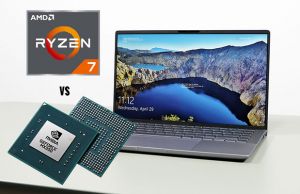
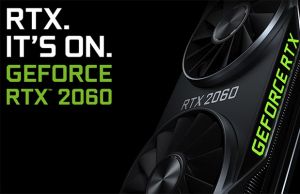




LHPSU
May 13, 2019 at 4:56 pm
The Gigabyte Aero 15 offers a GTX 1660 Ti option, and I'm wondering if I should get that or the RTX 2060 version for an additional $200 USD.
Andrei Girbea
May 13, 2019 at 5:18 pm
If you care about RayTracing, then yes. Otherwise, it's a hard sell, the RTX 2060 is faster in all games, but within 10-15% of the 1660Ti.
LHPSU
May 13, 2019 at 7:08 pm
Now that I think of it there's one issue – is there any way to know whether a notebook is using the 1660 Ti Max-Q or not? The 2060 has no Max-Q version as far as I know, but I don't know whether there's a significant difference in performance between the full-power and Max-Q versions of the 1660 Ti.
Andrei Girbea
May 13, 2019 at 7:37 pm
I'll have to further look into this matter, there usually is a TDP and performance difference between standard and max-Q implementations, but I don't know what to expect fot the 1660 Tis, as I haven't reviewed any of the Max-Q variants yet.
LHPSU
May 13, 2019 at 10:25 pm
Just checked out the Gigabyte website and they do mention the AERO 15 Classic's 2080 and 2070 as being Max-Q, but not the 1660 Ti. So I guess it's the full-powered version.
I wonder if it's even much slower than the top model. I've seen tests indicate that the 2070 Max-Q version is just 5% slower than the 2080 because of how thermal-constrained the Aero is, the 2060 is practically neck-to-neck with the 2070 Max-Q in most tests, and the 1660 Ti is just a little slower than the 2060.
If the 1660 Ti is indeed full-power, then it adds up to what, a 20% difference?
Andrei Girbea
May 14, 2019 at 10:11 am
We have a review of the 2070 Max-Q variant of the Aero 15 X on the site, as well as reviews of 206 models you can use for comparison. BUt yes, the 2060 in a good thermal implementation is within 5-10% of a good RTX 2070 Max-Q. So the 1660 TI should be within 20% of a good 2070 MQ, even less on the Aero.
Amirbahalegharn
May 23, 2019 at 2:43 am
yes there is max-q version for 1660ti as well,alongside 1650mq,etc..that's the way nvidia is doing to make money unfortunately.
again mq versions are 5-10% lower in performance..you could easily,if possible,overclock gtx1660ti and get nearly identical result with rtx2060 ones.so for now rtx2080 and rtx2060 aren't worthy if you aren't playing by 2K,4K or need ray tracing.
Michael
June 28, 2019 at 4:09 am
Best buy has a variant of the msi gs65 with a 1660ti.